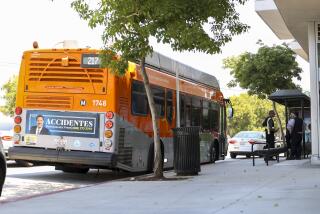Better Buses Long Overdue
Simple is beautiful--and maybe even attainable. That was the consensus among those who attended a meeting earlier this month of San Fernando Valley politicians and transportation planners trying to find a way out of gridlock and pollution. For years, Valley leaders held out the hope that rail would ease the region’s traffic congestion with a safe, comfortable and speedy alternative. That dream had a hard time dying but finally gasped its last in November, when voters blocked future rail construction. Now, Valley leaders are talking about much more modest solutions--but solutions that just might work.
For instance, Los Angeles County Supervisor Zev Yaroslavsky suggested building a network of lanes reserved for extra-long buses. The concept works in Curitiba, Brazil, where Yaroslavsky and a group of other politicians visited earlier this year. In Curitiba, extended buses capable of carrying 270 people beat the traffic by zipping along dedicated lanes built for a fraction of the cost of digging a subway tunnel. And a lot faster. Yaroslavsky predicted that the first such lanes tying the Valley together could be built within two years.
Preliminary lines could cross the Valley along major thoroughfares and existing railroad rights of way. They should be built so that they connect existing transit nodes and reduce crowding on busy routes. For instance, linking the Chatsworth Metrolink station to Warner Center with a bus corridor along Canoga Avenue would make it easier for workers in Ventura County to get to their jobs. And building a cross-Valley route along Burbank and Chandler boulevards would enable commuters from across the Valley to hop on a subway train headed downtown at the North Hollywood station scheduled to open next year.
Providing comfortable connections between buses and trains is key to luring more commuters out of their cars and reducing freeway congestion. But better, safer, faster bus service is long overdue in any case for residents dependent on public transportation. For them, Yaroslavsky’s proposal offers a hope that service along heavily traveled routes will improve to at least tolerable levels.
Yes, the improvements are far more modest than anyone envisioned even a few years ago. Assemblyman Wally Knox (D-Los Angeles) spoke for several of the politicians at the conference when he said the transportation debate in the Valley is shifting “away from utopian, quasi-solutions to things that work.” Rail systems may be expensive, but they are hardly “utopian” or “quasi-solutions.” They work in other cities and had the potential to work here in Southern California. Part of the reason they did not is that the politicians and bureaucrats charged with keeping the projects on course and under budget failed to do their jobs. The simple solutions now being proposed sound good, but those proposing them have an obligation to ensure that even these modest dreams come true.






